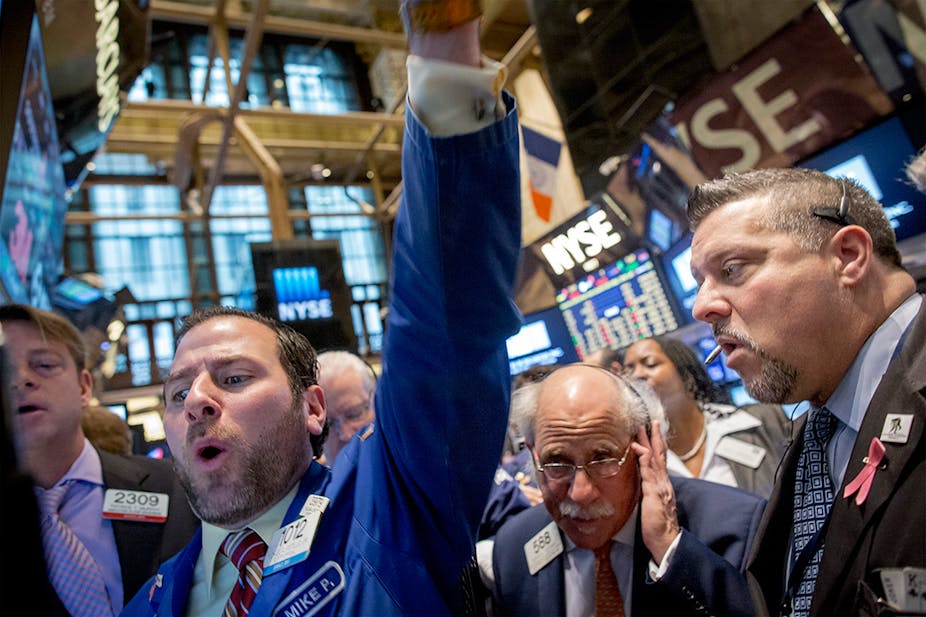A recent incident involving McDonald’s shows how negative news on one company can cause other businesses to suffer as well, but with a delay – an insight that could help small investors reap significant trading profits.
Claiming health and safety violations, the Russian government late last year shut down a string of McDonald’s restaurants and put several hundred more under heavy scrutiny. For the average Russian, McDonald’s Golden Arches symbolize American capitalism.
The Russian government’s move was viewed as a tactic to “exact revenge on America” for the Western sanctions following Russia’s invasion of Crimea and backing of rebels in Ukraine. McDonald’s earns a substantial chunk of its profit from Russian consumers, so the regulatory harassment hit the fast-food giant’s bottom line hard.
McDonald’s shares have flatlined since Russia first announced the investigation in August, while the Standard & Poor’s 500 and the Dow Jones Industrial Averaged have jumped about 6% over the same period. Although other factors have certainly affected the company’s share price – including competitive challenges in its domestic market – the sanctions likely weighed on McDonald’s stock price.
Other companies feel the pain
But the pain apparently wasn’t felt exclusively by the burger chain. Other companies that earn sizable revenues in the Russian market have also suffered. Shares of Ford, which sells a large number of vehicles to Russians, has lost 5.9% in the period. ExxonMobil, which is deeply invested in several Russian oil fields, has dropped 10%. Shares of US banks Citigroup and JP Morgan Chase, both with significant exposure to Russian assets, have barely budged.
Similar to the McDonald’s shares, other factors have undoubtedly contributed to the poor performance of these companies’ stocks. But even though the authorities haven’t gone after these corporations explicitly, investors know their Russian operations are vulnerable. McDonald’s setbacks signal the increased risks for all Western firms operating in Russia, and the uncertainty has only grown worse since then.

The McDonald’s example illustrates how news about a particular company may affect market values of other companies. Likewise, an accounting scandal may spill over to other firms that use the same auditors, a labor scandal may taint firms that use similar labor practices, a successful litigation may set the precedent for other firms to be sued, and so on.
Information may flow in unexpected directions: the company at the center of an important news development may be smaller, operate in a different industry and within a different supply chain than others also affected by the news. If investors do not know which news to follow, they may completely miss the relevant news affecting the stocks they hold.
Keeping tabs on the news is tough
Because of the sheer volume of financial news and information in the market, it is nearly impossible to keep track of all potentially relevant corporate announcements.
In research with co-authors Andreas Neuhierl and Bernd Schlusche, I estimated that about 218 corporate press releases reporting on companies’ valuation-relevant news are issued by publicly traded US firms on a typical day.
Of these, only 20% involve routine announcements about earnings, sales, dividends, plans to raise or return capital, etc. The remaining 80% are about new products, partnerships, strategic plans, corporate lawsuits, expansions to new markets, changes in management and other information that is much more difficult to quantify.
Leaders and followers
Bernd Schlusche, an economist with the Federal Reserve Board, and I found that stocks at the center of an important unfolding news development lead the returns of other affected stocks by reacting first to new information. We refer to the fast-reacting stocks as “return leaders” and to stocks whose returns lag behind as “return followers.”
How do we identify leaders and followers? We search for stocks that have been able to predict returns of other stocks over a trailing period of time, such as the previous one to three years.
In the McDonald’s incident, for example, its stock was the first to react to the news of Russia’s “retaliation,” because it was at the center of it, marking it as a leader. Other stocks that subsequently fell in value, apparently as a result of the McDonald’s news, would be the followers.
Our study shows that leader stocks’ predictive ability continues for some time in the future.
However, the leadership can be short-lived and disappear once the issue is resolved. Since a return leader is likely to be at the center of an important news development, we find that the stocks of companies with more news stories written about them tend to have more followers – that is, the stocks whose returns lag behind the leader’s returns.
How investors can profit
A company’s stock price reacts quickly to news about it, but our research shows that stock prices react to the relevant news of other firms with a delay.
The best way to earn a profit from trading on news is to trade the stocks of the firm’s followers. Sophisticated investors are using these trading strategies. But since the delay in the price reaction is rather short, portfolio turnover of this trading strategy is high. High portfolio turnover results in high trading costs, and trading costs are increasing in the size of trade.
Big institutional traders frequently leave money on the table because they have to trade large portfolios. Retail investors trade small dollar amounts and will incur lower trading costs. This would allow them to earn an after-trading-cost profit.
An old Wall Street adage goes: “buy on the rumor and sell on the news.” Unfortunately, retail investors do not hear nearly as many rumors as big Wall Street players. For retail investors, our advice would be: “buy or sell followers on the leaders’ news.”

